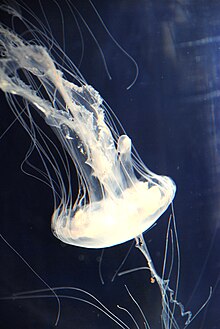Chrysaora quinquecirrha
This article needs additional citations for verification. (April 2009) |
| Atlantic sea nettle | |
|---|---|

| |
| Scientific classification | |
| Domain: | Eukaryota |
| Kingdom: | Animalia |
| Phylum: | Cnidaria |
| Class: | Scyphozoa |
| Order: | Semaeostomeae |
| Family: | Pelagiidae |
| Genus: | Chrysaora |
| Species: | C. quinquecirrha
|
| Binomial name | |
| Chrysaora quinquecirrha (Desor, 1848)
| |
| Synonyms | |
| |
The Atlantic sea nettle (Chrysaora quinquecirrha), also called the East Coast sea nettle in the United States, is a species of
Pacific sea nettle
, and has more variable coloration, but is typically pale, pinkish or yellowish, often with radiating more deeply colored stripes on the exumbrella, especially near the margin.
Description

The
organs. Each sea nettle is either in a free-swimming stage or a polyp stage. The free-swimming stage, or medusa stage reproduces sexually, and the polyp stage reproduces asexually
.
The Atlantic sea nettle is a bell-shaped
sting is rated from "moderate" to "severe" and can be noxious to smaller prey; it is not, however, potent enough to cause human death, except by allergic reaction. While the sting is not particularly harmful, it can cause moderate discomfort to any individual stung. The sting can be effectively neutralized by misting vinegar over the affected area. This keeps unfired nematocysts from firing and adding to the discomfort.[3]
Feeding habits
Stinging sea nettles are
ctenophores, other jellies, and sometimes crustaceans
. Sea nettles immobilize and obtain their prey using their stinging tentacles. After that, the prey is transported to the gastrovascular cavity where it is subsequently digested.
Sea nettles are also able to consume minnows, bay anchovy eggs, worms, and mosquito larvae.
Defense mechanisms
Each sea nettle tentacle is coated with thousands of microscopic
mononeuritis.[4]
Rather than toxic substances, some cnidocytes contain adhesion used to entangle or anchor its target.
Predators
The defense mechanisms of the sea nettle reduces the amount of natural predators. The Atlantic sea nettle is prey to mainly sea turtles, ocean sunfish, and larger jellyfish.[5]
See also
- Sea wasp
References
- ^ PMID 29043109.
- .
- ^ "Jellyfish Stings".
- ISBN 978-0-7817-2845-4.
- ^ "Chrysaora quinquecirrha (Sea nettle)". Animal Diversity Web. Retrieved 2016-10-30.
- MacKay, Bryan (1995). Hiking, Cycling, and Canoeing in Maryland: A Family Guide. Johns Hopkins University Press. pp. 244–245. ISBN 978-0-8018-5035-6.
External links
Wikimedia Commons has media related to Chrysaora quinquecirrha.
